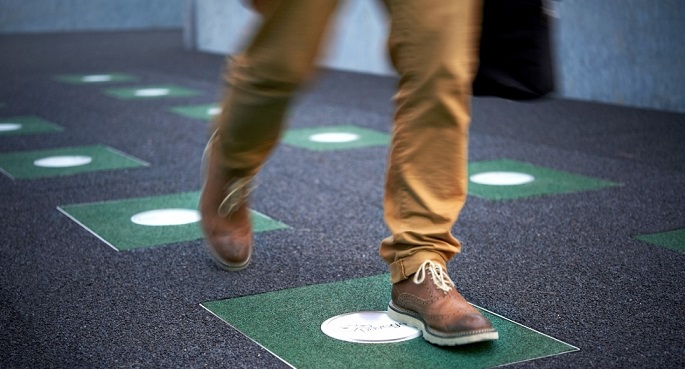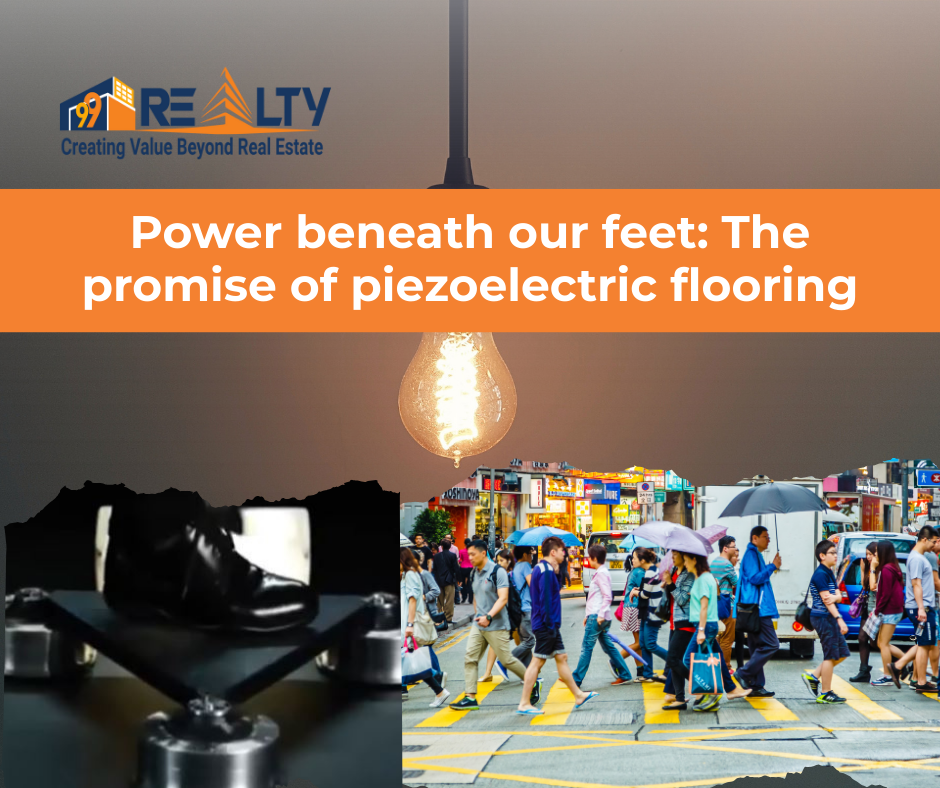Imagine if every step you took could light up a bulb. Sounds like a scene from a sci-fi movie, right? Well, Japan has already made it real. In places like Shibuya Crossing and Tokyo Station, footsteps aren’t just creating noise—they’re generating electricity. Through piezoelectric floor tiles, Japan is converting human movement into clean, renewable energy.
Now, here’s the exciting part: India, a country with some of the busiest public spaces in the world, could turn this very technology into a game-changer. Let’s explore how it works and why it might just be the solution to India’s energy crisis.
Sustainable Real Estate Development Paving the Way for a Greener India
What Are Piezoelectric Floor Tiles?

The Science of Piezoelectric Effect
The word piezo comes from the Greek word for “pressure.” When certain materials—like quartz, ceramics, or crystals—are pressed, squeezed, or bent, they generate an electric charge. This is the “piezoelectric effect.”
Think of it as the material “crying out” in electricity every time you step on it.
Everyday Examples of Piezoelectricity
You’ve probably used piezoelectricity without even realizing:
- The spark in your gas lighter? That’s piezoelectric.
- The ultrasound machines in hospitals? Same principle.
- Even your wristwatch quartz crystal works because of it.
Now, extend that tiny spark to millions of footsteps. That’s where piezoelectric floor tiles step in.
How Japan is Using Footsteps for Power
Case Study: Shibuya Crossing
Shibuya Crossing in Tokyo sees over 2.4 million pedestrians daily. By embedding piezoelectric tiles under certain sections, each footstep generates small bursts of electricity—enough to power nearby billboards and LED displays. It’s not huge, but it’s symbolic and functional.
Bollywood’s Mansion Sales: Panic or Power Play Strategy?
Tokyo Station Experiment
Tokyo Station, one of the busiest train stations in the world, piloted tiles on its concourse. The energy generated helped power ticket gates and LED indicators. Small, but imagine scaling it across hundreds of stations.
How Do These Tiles Work Exactly?
The Pressure-to-Power Conversion
Every footstep applies mechanical stress on the tile. Inside, piezoelectric crystals compress and release an electric charge. This charge is collected, stabilized, and stored in batteries or capacitors.
Storage and Grid Connection
The energy doesn’t just vanish. It’s stored and can be:
- Used for immediate small-scale needs (lights, signs, charging points).
- Or fed into the grid as supplementary power.
Limitations of Current Technology
Let’s be clear—one step doesn’t power a fan. Each footstep produces just a few watts. But multiply that by millions of steps in India’s crowded spaces, and suddenly, it adds up.
Why This Matters for Energy-Deficit Countries
India’s Current Energy Scenario
India is the world’s third-largest energy consumer. Yet, power cuts are still common in towns and villages. Peak demand often exceeds supply, leading to blackouts.
The Problem with Traditional Power Sources
Coal may dominate India’s power sector today, but it comes at a heavy cost—pollution, depletion of resources, and rising climate concerns. While solar and wind are rapidly expanding, they aren’t without limitations: solar depends on daylight and weather, wind needs suitable geography, and both demand large tracts of land and storage solutions. This is where piezoelectricity steps in as a fresh, untapped dimension. By combining conventional renewables with innovative tech like footstep-generated power, India can build a more resilient, diversified, and sustainable energy mix—a true step forward in battling the energy crisis.
India’s Crowded Spaces: A Hidden Goldmine of Energy
Railway Stations
Indian Railways serves 23 million passengers daily. Imagine platforms and concourses covered with piezoelectric tiles. Each ticket gate could run entirely on footstep power.
Metro Stations
Delhi Metro alone sees over 5 million footfalls daily. That’s more steps than some countries’ populations!
Religious Pilgrimage Sites
Vaishno Devi, Tirupati Balaji, Kashi Vishwanath—these see tens of thousands of pilgrims daily. Devotees’ footsteps could literally power temple lights.
Malls, Stadiums, and Airports
From Eden Gardens in Kolkata to Wankhede in Mumbai, stadiums attract massive crowds. Airports like Delhi’s IGI and Mumbai’s T2 are human traffic hubs—perfect grounds for this technology.
Potential Power Output: A Realistic Estimate
Example Calculation with Indian Footfall
- One footstep: ~5 watts (for a split second).
- 1,000 people stepping per minute in a metro station = 300,000 watts/hour.
- That’s enough to power 10,000 LED bulbs for an hour.
Scale it across India’s 7,000 railway stations and you have a new national power source waiting beneath our feet.
Advantages of Adopting Footstep Power in India
Clean and Green
Unlike coal, which chokes the air with smoke and carbon emissions, footstep power is as clean as it gets. Every step you take becomes a micro energy generator without leaving behind pollution, greenhouse gases, or toxic waste. It’s renewable in the truest sense—because as long as people are moving, energy is being created. Think about it: in a country like India, where millions walk through train stations, metro hubs, markets, and pilgrim sites daily, the sheer volume of clean electricity that can be tapped is enormous.
Explore the Benefits of Green Building Certifications in Real Estate
Decentralized Energy Source
Traditional power comes from plants located far away, which means it needs to be transmitted over long distances—leading to energy loss along the way. Footstep power flips the model. The energy is produced right where it’s needed—whether that’s a metro concourse, a shopping mall, or a busy temple corridor. This decentralization means fewer transmission losses, localized self-sufficiency, and faster access to power for specific needs like lighting, signboards, ticket machines, or charging kiosks.
Boost for Smart Cities
India’s Smart Cities Mission is all about integrating technology with daily life to improve sustainability and efficiency. Piezoelectric flooring fits perfectly into this vision. Imagine a smart railway station that powers its own lights as passengers walk, or a shopping mall that uses visitor footsteps to charge mobile docking stations. It’s futuristic, practical, and aligns directly with India’s push to showcase itself as a global leader in urban innovation.
Challenges and Roadblocks
High Installation Costs
Currently, the biggest hurdle is the cost of piezoelectric tiles. They’re still a specialized technology, which means manufacturing is limited and prices are high. Without government subsidies or bulk adoption to bring down the costs, rolling this out across India might feel financially daunting. But here’s the catch: so were solar panels 15 years ago, and today, they’ve become affordable thanks to scaling. The same can happen with footstep power if India invests early.
Maintenance and Durability
Think of the beating that floors in Indian public spaces take every day—dust, heavy luggage, spilled drinks, high heels, and millions of footsteps. Piezoelectric tiles must be tough enough to survive this daily punishment without frequent repairs. Maintenance costs could rise if the tiles aren’t designed for rugged Indian conditions. Hence, durability will be just as important as energy output.
Lack of Awareness and Policy Support
Right now, piezoelectricity is seen more as a “fancy experiment” than a serious energy solution. For it to be widely adopted, policymakers, city planners, and investors need to recognize its potential. Awareness campaigns, pilot projects, and government incentives could play a huge role in changing perceptions and encouraging large-scale adoption.
Global Examples Beyond Japan
UK’s Heathrow Airport
Heathrow Airport tested piezoelectric tiles in its passenger terminals to power lighting and display systems. The experiment proved that even in high-pressure, real-world conditions, the technology could perform consistently. For India’s equally busy airports, this is a direct inspiration.
Netherlands’ Dance Floors
In Rotterdam, nightclubs turned dance floors into mini power stations. As people danced, their energy powered the lighting of the entire floor. It became both a functional innovation and a crowd attraction. For India, think about how this could be applied to concerts, weddings, or even cricket stadiums, where human energy is abundant and waiting to be tapped.
The Roadmap for India
Pilot Projects in Metro Cities
India can begin with small, impactful experiments. For example, installing tiles at Delhi’s Rajiv Chowk Metro station or Mumbai’s Chhatrapati Shivaji Terminus could showcase their real-world potential. Success in just a handful of high-visibility projects could trigger nationwide interest.
Public-Private Partnerships
Footstep power can be paired with IoT (Internet of Things) sensors, AI-based monitoring, and data analytics. For example, real-time dashboards could track energy generated per footstep at a railway station, making cities more interactive, sustainable, and transparent. This could become a key feature of India’s smart urban ecosystem.
Integration with Digital India & Smart Cities
Pairing footstep power with IoT and AI could create self-sustaining, intelligent public spaces.
Future Possibilities
Hybrid with Solar and Wind
No single renewable source can solve India’s energy challenge alone. But combine them, and the picture changes. Imagine a metro station roof covered with solar panels, nearby areas using small wind turbines, and the concourse fitted with piezoelectric tiles. Together, they form a hybrid system that ensures steady energy generation in all conditions.
Footstep-Powered Street Lights
Picture this: as people walk along a street, their steps directly power the lamps overhead. No need for external electricity. This isn’t just efficient—it’s magical. Such interactive lighting could be a game-changer for busy Indian streets, campuses, and shopping areas, where energy is often wasted on lighting that could instead be powered by the people walking beneath them.
Conclusion
Piezoelectric tiles might not single-handedly solve India’s energy problems, but they can definitely play a crucial role. With crowded stations, bustling streets, and endless footfall, India is sitting on an untapped goldmine of human energy. Japan has shown the world what’s possible—now it’s India’s turn to step up, quite literally, and walk its way toward a cleaner, brighter future.
FAQs
1. Can footsteps really power an entire city?
Not yet. Footstep power is supplementary. But in high-footfall areas, it can power lights, gates, and small devices.
2. How much energy does one step generate?
On average, one step generates 2–5 watts for a moment. With millions of steps, it adds up quickly.
3. Is it expensive to install piezoelectric tiles?
Yes, the initial cost is high, but mass adoption can reduce prices, just like solar panels did over the years.
4. Can it work in rural India?
Rural areas may not have the same footfall as cities, so the impact would be limited. But in pilgrimage spots, it could work.
5. When can India expect to see this technology widely used?
If pilot projects succeed and policies support it, India could see large-scale implementation within the next 5–10 years.
Need Help?
Need help evaluating a property or planning your next move in the market?
Reach out to 99 REALTY – your trusted real estate partner for smarter choices.
Subscribe to get updates on our latest posts and market trends.






Join The Discussion